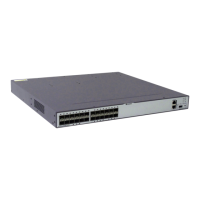Step 3 Run the following command as required:
l Run:
apply cost [ + | - ] cost
The cost of the route is set.
l Set the cost type of the route.
– Run the apply cost-type { external | internal } command to set the cost type of an IS-
IS route.
– Run the apply cost-type { type-1 | type-2 } command to set the cost type of an OSPF
route.
The apply cost-type { external | internal } command and the apply cost-type { type-1 |
type-2 } command are mutually exclusive and cannot be configured at the same time.
l Run:
apply ip-address next-hop { peer-address | ipv4-address }
The next hop address of the IPv4 route is set.
l Run:
apply ipv6 next-hop { peer-address | ipv6-address }
The next hop address of the IPv6 route is set.
l Run:
apply isis { level-1 | level-1-2 | level-2 }
The route level of IS-IS is set.
l Run:
apply ospf { backbone | stub-area }
The area of the OSPF that routes are imported into is set.
l Run:
apply preference preference
The preference of the routing protocol is set.
The smaller the preference value, the higher the preference.
l Run:
apply tag tag
The tag of the route is set.
The commands in Step 3 can be used regardless of the order.
----End
10.4.5 Checking the Configuration
After the Route-Policy is configured, you can check information about the Route-Policy.
Prerequisites
The configurations for the Route-Policy are complete.
Procedure
l Run the display route-policy [ route-policy-name ] command to check the Route-Policy.
----End
S6700 Series Ethernet Switches
Configuration Guide - IP Routing 10 Routing Policy Configuration
Issue 01 (2012-03-15) Huawei Proprietary and Confidential
Copyright © Huawei Technologies Co., Ltd.
601

